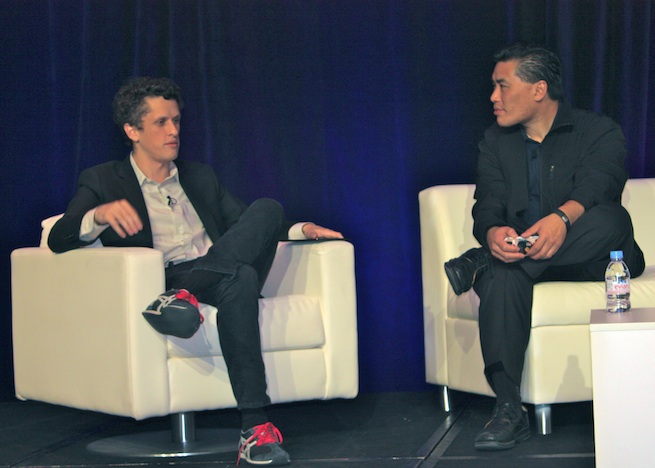LOS ANGELES — For Yammer‘s cofounder, user-experience design may be a solution for large companies getting their “asses handed to them” by scrappy startups.
[aditude-amp id="flyingcarpet" targeting='{"env":"staging","page_type":"article","post_id":572508,"post_type":"story","post_chan":"none","tags":null,"ai":false,"category":"none","all_categories":"big-data,business,cloud,enterprise,","session":"B"}']Today, Yammer’s Adam Pisoni and Box‘s Aaron Levie took to the stage at Connected Enterprise, Constellation Research’s annual conference.
This year’s underlying theme is bringing design thinking to the enterprise. IDEO‘s general manger, Tom Kelley, kicked off the conference with a keynote on how large companies can build a niche in their organization to test new ideas. IDEO is the firm that famously designed Apple’s first mouse.
AI Weekly
The must-read newsletter for AI and Big Data industry written by Khari Johnson, Kyle Wiggers, and Seth Colaner.
Included with VentureBeat Insider and VentureBeat VIP memberships.
Young founders like Pisoni and Levie have long preached that enterprise software is sexy again. In recent months, investors and the media have caught up. Silicon Valley’s venture capitalists are pouring millions of dollars into young companies that are taking aim at legacy vendors like SAP, Oracle, and IBM.
According to Pisoni and Levie, the interest in cloud and “big data” startups won’t die down anytime soon.
“The enterprise is so ripe for more disruption,” said Pisoni, CTO and cofounder of Yammer, the enterprise social network acquired by Microsoft. “The consumer space is pretty played out at the moment.” Read more about under-30 enterprise founders at companies like Box and Huddle here.
From its early days, Yammer threw out traditional engineering methods in favor of a new software development process. The company does not demarcate its engineers by product type or specialty. No person or group owns a product area; there are no search engineers, for instance. Instead, each team spends between two and 10 weeks on a project and then moves on. “It’s about being data driven, humble, and very iterative,” said Pisoni.
This process allows them to test “every crazy idea,” he explained. Before implementing a new feature, the company will closely monitor how users react to it. “The data keeps us intellectually honest,” he said.
Likewise, Levie revealed how Box, the cloud storage startup founded in 2005, has kept its competitive edge through A/B testing, customer feedback, and continuous product updates. “Most people are surprised that we have some updates to the site every day,” he said. “It’s a train that is always moving.”
[aditude-amp id="medium1" targeting='{"env":"staging","page_type":"article","post_id":572508,"post_type":"story","post_chan":"none","tags":null,"ai":false,"category":"none","all_categories":"big-data,business,cloud,enterprise,","session":"B"}']
According to Levie, who took to the stage minutes after Pisoni (pictured above in his trademark neon sneakers), the remaining challenge to growth is the dearth of technical talent. “If you’re a wicked PHP engineer, we’ll hire you right now, sight unseen,” he joked.
“The software you’ll see in the enterprise needs to be far easier to use,” said Levie. In terms of user experience, he said that Pinterest (the addictive technology that lets you share your virtual pin-board) is 10 times better than the current suite of enterprise software tools.
Yammer may find it even more challenging to improve its user experience post-acquisition (Yammer was picked up by Microsoft for $1.2 billion). When asked how the company will keep up the pace of innovation, Pisoni stressed that it will not be stalled. “We don’t have to go out and build all the stuff that they already have,” he said.
Yammer has been heads down for several months on-boarding 65,000 Microsoft executives to the system and bringing new methods to the software giant. “We are bringing a greater sense of connection to Microsoft,” he said. “It’s a way to break down those organizational silos.”
[aditude-amp id="medium2" targeting='{"env":"staging","page_type":"article","post_id":572508,"post_type":"story","post_chan":"none","tags":null,"ai":false,"category":"none","all_categories":"big-data,business,cloud,enterprise,","session":"B"}']
For these founders, the best way enterprise startups can be disruptive (and large enterprises can compete with them) is by experimenting with “freemium” models. “The future of work is changing,” said Pisoni. “Companies should prove value and sell customers on their vision — and make money later.”
To continue the conversation about design thinking and the enterprise, join us at CloudBeat.
Images // Sarah Seegal
VentureBeat's mission is to be a digital town square for technical decision-makers to gain knowledge about transformative enterprise technology and transact. Learn More

